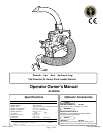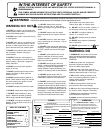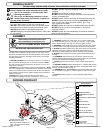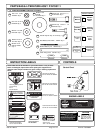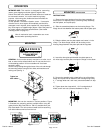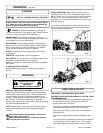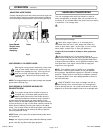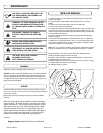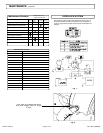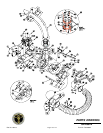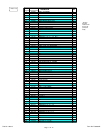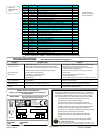
Part No. 790161 Form No. F032399A
PUT OIL IN ENGINE BEFORE STARTING.
Page 6 of 12
OPERATION continued
HOSE CARE & USE TIPS
FOR BEST HOSE OPERATION RESULTS, FOLLOW THESE
RECOMMENDATIONS.
Be sure the hose is correctly installed by checking that the
arrow printed on the hose indicating flow direction is
pointing toward the vac housing.
Keep hose as straight as possible and avoid sharp bends
during operation for best pick-up and to avoid clogs.
Never drag hose. Always remove and store hose before
transporting unit.
THE HOSE IS A REPLACEABLE WEAR ITEM.
Store hose straight and flat to maintain flexibility for next
use.
To increase hose life, periodically rotate hose and reposition
nozzle and coupler on front plate of unit. This increases
hose life by keeping hose from wearing only on one side.
INTAKE OPERATION: With machine running and fully
assembled, move the nozzle in sweeping motions over
debris. Always allow air to flow into the nozzle along with
the debris. Do not completely block the nozzle when
vacuuming, it will reduce performance, and increase clog-
ging (See figure 3).
For removal of heavier debris, or debris that is stuck to the
ground, rock nozzle forward to concentrate suction power
around the debris (See figure 4).
Fig. 3
Fig. 4
ENGINE: See engine manufacturer’s instructions
for type and amount of oil and gasoline used. Engine must be
level when checking and filling oil and gasoline.
ENGINE SPEED: Controlled by throttle lever on the vac
housing. Under normal conditions, operate at minimum throttle
to accomplish your current cleaning task.
INTAKE HOSE: Hose mounting assembly must be properly
attached to vac housing and safety switch must be engaged
before engine will start. Note: Any damage to the switch or
wiring harness will prevent engine from starting.
CHOKE: Located on the vac housing as part of the engine
control panel.
THROTTLE: Move throttle control to fast position.
KEY SWITCH: Turn to start position until engine begins to fire,
immediately release the key to the run position.
Note:
Do not hold key in start position more than 10 seconds
per attempt.
IF YOUR UNIT FAILS TO START:
See Troubleshooting on page 12. Also see engine owner's
manual.
Inspect machine work area and machine before operat-
ing. Make sure that all operators of this equipment are
trained in general machine use and safety.
STARTING
EXHAUST DIRECTION & DISTANCE: Exhaust direction and
distance are controlled by the angle of the exhaust deflector
and by rotation of the exhaust elbow. Adjust the angle of the
exhaust deflector to control the distance that debris is dis-
charged. Typically debris is aimed to discharge to the rear of
the container. The direction of discharge is adjusted by
loosening the knobs on the exhaust elbow clamp and rotating
the elbow to the desired direction.
NOTE:
Elbow is heavy. Use caution when adjusting. Never
stand directly under the elbow while adjusting direction of
exhaust.
Never adjust exhaust deflector angle or direction of
discharge while unit is running.
Never direct exhaust into an area where bystanders
may cross the path of the debris.
OPERATION
DO NOT OPERATE UNLESS
DEBRIS IS DISCHARGING
INTO AN ENCLOSED
CONTAINER
KEEP ENGINE CLEAN OF DEBRIS



